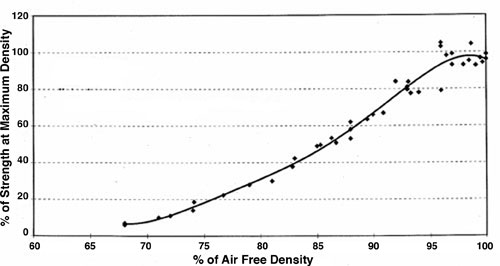 Similar to conventional concrete, RCC must be consolidated or in the case of roller-compacted concrete (RCC), compacted in order to achieve the desired performance characteristics. The degree of compaction of RCC has a direct role on its ultimate strength and durability. Because of roller-compacted concrete’s very dry consistency and reduced workability, adequate compaction of roller-compacted concrete can be more difficult to achieve than with conventional concrete. Compaction of RCC depends upon many variables including materials used, mixture proportions, mixing, transporting and placement methods used, compaction equipment, lift thickness, and time of compaction.
Similar to conventional concrete, RCC must be consolidated or in the case of roller-compacted concrete (RCC), compacted in order to achieve the desired performance characteristics. The degree of compaction of RCC has a direct role on its ultimate strength and durability. Because of roller-compacted concrete’s very dry consistency and reduced workability, adequate compaction of roller-compacted concrete can be more difficult to achieve than with conventional concrete. Compaction of RCC depends upon many variables including materials used, mixture proportions, mixing, transporting and placement methods used, compaction equipment, lift thickness, and time of compaction.
The best performance characteristics are obtained when the roller-compacted concrete is reasonably free of segregation and compacted throughout the entire lift at, or close to, maximum density. Research studies including the one below have shown that the strength of RCC drops appreciably as the density drops. (Figure 1).

Figure 1. Strength vs. density for various RCC mixtures (Schrader)
Data from the figure indicates that for compacted densities between 97 to 100 percent of theoretical air-free density (TAFD), the compressive strength of RCC showed little variation. However, as the density drops below 96 percent, significant strength loss occurs. This is why most specifications require a minimum density of at least 98 percent of maximum density, based on a modified Proctor density (MPD). (Note: 98 percent of MPD is not equivalent to 98 percent of TAFD because there are some voids – typically 0.5 to two percent - in the MPD).

In obtaining the specified density, it’s important to recognize that delays in compaction, segregation of material, inadequate compaction equipment, too thick of lifts, and insufficient water in the mixture are some of the issues that may lead to reduced density and subsequent strength loss. On the other hand, over-compaction can lead to a weaken roller-compacted concrete surface by loosening of the material directly under the roller.
The recommended approach is to determine an optimum rolling pattern that will result in the specified minimum density being met in the least amount of time and passes. This can be determined either during a trial placement or early in the construction process. Additional rolling that will not result in an increased density should be avoided.
Reference:
Schrader, E.K., “Roller-Compacted Concrete for Dams – State of the Art”, International Conference on Advances in Concrete Technology, Athens, Greece, May 1992.